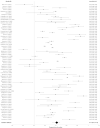Sex Disparity for Patients with Cutaneous Squamous Cell Carcinoma of the Head and Neck: A Systematic Review
- PMID: 36497312
- PMCID: PMC9740937
- DOI: 10.3390/cancers14235830
Sex Disparity for Patients with Cutaneous Squamous Cell Carcinoma of the Head and Neck: A Systematic Review
Abstract
The incidence of head and neck cutaneous squamous cell carcinoma (HNcSCC) is unevenly distributed between men and women. At present, the mechanism behind this disparity remains elusive. This study conducted a systematic review and meta-analysis of proportions to investigate the disparity between sexes for patients with HNcSCC. PubMed, Scopus, EMBASE, MEDLINE, Emcare and CINAHL were searched in November 2021 and June 2022 (N > 50, English, human), and studies which examined the association between sex and HNcSCC were included. Analysis was conducted using RStudio with data and forest plots displaying males as a proportion of total patients with HNcSCC. Two independent researchers performed study selection, data extraction, data analysis and risk of bias. Eighty-two studies (1948 to 2018) comprising approximately 186,000 participants (67% male, 33% female) from 29 countries were included. Significantly more males had HNcSCC overall (71%; CI: 67−74). Males were also significantly more affected by cSCC of the ear (92%; CI: 89−94), lip (74%; CI: 66−81), and eyelid (56%; CI: 51−62). This study found HNcSCC disproportionately affected males overall and across all subtypes. Improving our understanding of sex-specific mechanisms in HNcSCC will better inform our preventive, therapeutic and prognostic practices.
Keywords: cutaneous; head & neck; squamous cell carcinoma; surgery.
Conflict of interest statement
The authors declare no conflict of interest.
Figures





Similar articles
-
p16 expression in cutaneous squamous cell carcinoma of the head and neck is not associated with integration of high risk HPV DNA or prognosis.Pathology. 2017 Aug;49(5):494-498. doi: 10.1016/j.pathol.2017.04.002. Epub 2017 Jun 26. Pathology. 2017. PMID: 28663082
-
Multivariate analysis of potential risk factors for lymph node metastasis in patients with cutaneous squamous cell carcinoma of the head and neck.J Am Acad Dermatol. 2016 Oct;75(4):722-730. doi: 10.1016/j.jaad.2016.06.010. Epub 2016 Jul 26. J Am Acad Dermatol. 2016. PMID: 27473455
-
High-Risk Cutaneous Squamous Cell Carcinoma of the Head and Neck: A Clinical Review.Ann Surg Oncol. 2021 Dec;28(13):9009-9030. doi: 10.1245/s10434-021-10108-9. Epub 2021 Jun 30. Ann Surg Oncol. 2021. PMID: 34195900 Review.
-
Is high-risk cutaneous squamous cell carcinoma of the head and neck a suitable candidate for current targeted therapies?J Clin Pathol. 2020 Jan;73(1):17-22. doi: 10.1136/jclinpath-2019-206038. Epub 2019 Jul 12. J Clin Pathol. 2020. PMID: 31300530
-
Metastatic patterns and treatment options for head and neck cutaneous squamous cell carcinoma (Review).Mol Clin Oncol. 2024 Apr 24;20(6):40. doi: 10.3892/mco.2024.2739. eCollection 2024 Jun. Mol Clin Oncol. 2024. PMID: 38756868 Free PMC article. Review.
Cited by
-
Risk Factors and Innovations in Risk Assessment for Melanoma, Basal Cell Carcinoma, and Squamous Cell Carcinoma.Cancers (Basel). 2024 Feb 29;16(5):1016. doi: 10.3390/cancers16051016. Cancers (Basel). 2024. PMID: 38473375 Free PMC article. Review.
-
A retrospective analysis of drugs associated with the development of cutaneous squamous cell carcinoma reported by patients on the FDA's adverse events reporting system.Arch Dermatol Res. 2024 May 25;316(6):250. doi: 10.1007/s00403-024-03109-7. Arch Dermatol Res. 2024. PMID: 38795220 Free PMC article.
-
Sex as a Predictor of Response to Immunotherapy in Advanced Cutaneous Squamous Cell Carcinoma.Cancers (Basel). 2023 Oct 17;15(20):5026. doi: 10.3390/cancers15205026. Cancers (Basel). 2023. PMID: 37894393 Free PMC article.
-
A CT-based radiomics tumor quality and quantity model to predict early recurrence after radical surgery for colorectal liver metastases.Clin Transl Oncol. 2025 Mar;27(3):1198-1210. doi: 10.1007/s12094-024-03645-8. Epub 2024 Aug 17. Clin Transl Oncol. 2025. PMID: 39153176
-
Dual-center retrospective cohort analysis of high-risk cutaneous squamous cell carcinoma tumors.Arch Dermatol Res. 2025 Jan 20;317(1):300. doi: 10.1007/s00403-024-03712-8. Arch Dermatol Res. 2025. PMID: 39833534
References
-
- Elliott B., Douglass B.R., McConnell D., Johnson B., Harmston C. Cutaneous squamous cell carcinoma: Predictors of positive and close margins and outcomes of re-excision in Northland, New Zealand. New Zealand Med. J. 2018;131:23–29. - PubMed
Publication types
LinkOut - more resources
Full Text Sources

